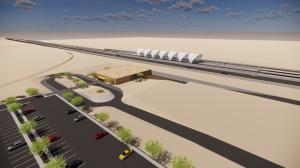Vegas-to-SoCal Rail Construction Begins
By Greg Cornfield April 22, 2024 3:55 pm
reprints

Brightline West broke ground Monday on what will become the United States’ first high-speed rail system, which will connect Las Vegas to Southern California in two hours, or almost half the time as driving.
The 218-mile system will run electric trains capable of going 200 miles per hour in the middle of the I-15 corridor in one of the largest privately led infrastructure projects in the nation. The goal is to have the system fully operational in time for Los Angeles to host the Summer Olympic Games in 2028.
The project was recently awarded $3 billion from the federal government. The rest of the project will be privately funded and has received $3.5 billion in private activity bonds from the U.S. Department of Transportation.
“Partnering with state leaders and Brightline West, we’re writing a new chapter in our country’s transportation story that includes thousands of union jobs, new connections to better economic opportunity, less congestion on the roads, and less pollution in the air,” U.S. Transportation Secretary Pete Buttigieg said in a statement.
The system will have an 80,000-square-foot station near the Las Vegas Strip. A 20,000-square-foot station will be on a 300-acre parcel in Victor Valley in San Bernardino County. It is intended to be a connection to the High Desert Corridor and California High Speed Rail, other planned rail systems that will include bullet trains.
Other stops will be in Hesperia, Calif., and at an 80,000-square-foot station in Rancho Cucamonga, Calif. That last stop is on a 5-acre property at the northwest corner of Milliken Avenue and Azusa Court near the Ontario International Airport. It will connect to California Metrolink, which connects to Downtown L.A. about 40 miles west, and other locations in L.A., Orange, San Bernardino and Riverside counties.
Additionally, a 200,000-square-foot building located on 238 acres in Sloan, Nev., will be a base for daily maintenance and staging of trains. A second staging area and facility will be next to the Victor Valley station.
Brightline said the $12 billion investment will create more than $10 billion in economic impact for Nevada and California, and will generate more than 35,000 jobs.
Gregory Cornfield can be reached at gcornfield@commercialobserver.com.



